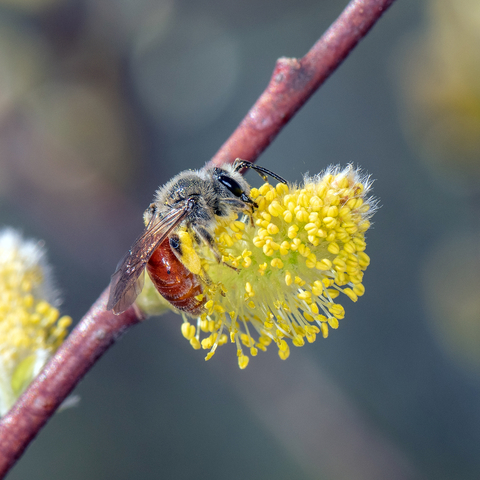Ecosystems are complex networks of organisms, from the bacteria in the soil to the largest mammals in the forest. These living communities evolve to become well-adapted to their environment and each other, creating a careful balance that can be upset by things like climate change and the introduction of non-native species.
As these changes occur, people may begin to notice shifts in the makeup of the forest. Perhaps things that historically grew in one area no longer perform quite so well.
As climate norms in Minnesota shift warmer and wetter, a prudent landowner or forest steward may want to consider tree and plant species that are already adapted to similar conditions.
Plants with native ranges slightly to the south are likely the best candidates to succeed in Minnesota’s future climate — and we really need them to succeed.
All creatures rely on plants
In addition to being the foundation of the food chain, plants contribute to the ecosystem by providing essential services such as shelter, water and soil filtration, oxygen production and carbon sequestration.
Every living thing relies on plants. Small herbivores like hazelnut lace bugs and rabbits, and omnivores, including many ants and raccoons, rely on plants for all or most of their food. And carnivores, such as tiger beetles or Minnesota’s native bat species, rely indirectly on plants to support the animals they eat at some point lower on their food chain.
As we develop tree and plant recommendation lists for regions across Minnesota, we continue to prioritize species that are native, climate resilient and provide critical ecosystem functions. Meeting those three thresholds makes them more likely to succeed at supporting the local wildlife.
By only considering understory plants native to Minnesota (or the larger eastern U.S. forest in the case of trees), we are hoping to maintain habitat for the small forest creatures we all love, like bees, birds and fireflies. We call these charismatic microfauna and we like to think of them as tiny ecosystem ambassadors.
Changing perspectives on healthy forests
As natural resources professionals, we use the term "charismatic" more broadly than you might imagine. Instead of large, appealing animals like polar bears and tigers (megafauna) hogging all the charisma, we think it’s perfectly reasonable to find smaller critters just as charming. And though these charismatic microfauna may not be large, they inspire similarly-impassioned love and conservation efforts. For instance:
- The Minnesota Bumble Bee Atlas is working hard to study and improve pollinator habitat, including that of our state bee, the rusty patched bumble bee.
- The U.S. Fish and Wildlife Service is growing concerned about the northern long-eared bat, now listed as endangered under the Endangered Species Act (ESA).
- Americans love our feathered friends, with 45 million of us spending approximately $41 billion dollars a year to watch birds.
- And certain members of the Extension Forestry team are fervently hoping to catch a glimpse of the elusive flying squirrel. Perhaps we’ll have better luck finding these nocturnal creatures with the right equipment — flying squirrels glow fluorescent pink under ultraviolet light!
Focusing on the health of plants and small animals creates a resilient ecosystem where charismatic megafauna (like deer, grouse, turkey, bear, wolf, elk and moose) will also thrive.
Creating a resilient ecosystem also means reconsidering any native insects that have historically been considered pests on native trees, often regardless of the degree of damage they do to the tree or forest. For the most part, we’re reframing these pests as intrinsic members of their ecosystems, just as much in need of food and shelter as other species, and thus including them as we look at a tree or plant's ability to support these small animals.
Rewilding is an approach to landscape stewardship that emphasizes biodiversity and restoring natural processes, but it specifically remains open to novel or emerging ecosystems with new combinations of species.
We recognize that it is a tremendous shift to go from recommending aspen and red pine for Minnesota’s North Shore, to instead recommending newcomers like sycamore, bigleaf magnolia and sweetgum. But introducing new or unusual trees will help steward a thriving, healthy, resilient and productive forest ecosystem. Hopefully, it will be a different ecosystem with many of the same species.
Change is hard, but can come with hope
Climate change anxiety is real and can take many forms. It’s reasonable to experience anticipatory grief today about the likely loss of Minnesota’s aspen, birch and red pine forests. Ambiguous loss, unclear loss without closure, is also common when thinking about our changing climate. We don’t know how to stop the problem, and each day may bring another pang of loss or discomfort related to air quality alerts, forest fires, record heat, drought or intense storms. We experience a loss of normal activity and lack clarity on how and if that will ever change.
Rewilding can also cause stress. There’s a risk that species new to Minnesota won’t survive and thrive, or they’ll do too well and become problematic. But doing nothing may be much worse than accepting this risk and trying a few unusual trees to improve the odds that Minnesota’s forests are resilient to the stresses they will have to endure. In doing so, we may also create valuable habitat for species moving north as their ranges expand due to climate change, like the Minnesota newcomer evening bat.


